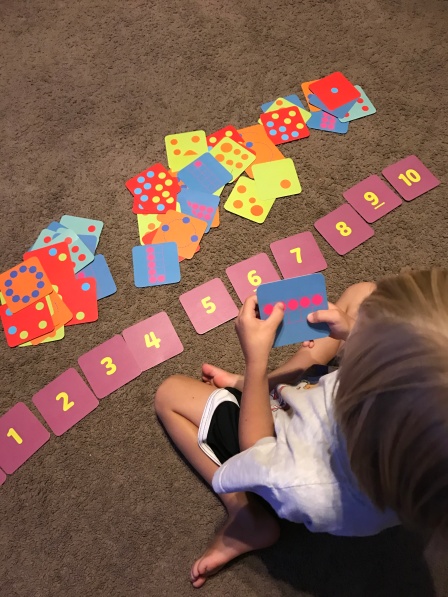More than a few times, I have been asked if we have a classroom. That question is usually followed by other questions, because it’s not the most straightforward answer. We live in a very small house, so our classroom is actually our dining room. Though we don’t always do our school work in it. We do a lot outside (weather permitting), and in the living room; where we have a child-size table with two stools, and the comfort of the couch and recliners. Since I have been asked so often how I set up a classroom and a dining room, and since I myself am curious about other people’s organizational methods, I thought I might show you all how it looks.


This is an overall view. We’re big on pretend play, so obviously we have a play kitchen stocked to the max with pretend food. And I also have to have everything organized and stored well; so shelves, cabinets, and drawer carts are my friends. My favorite thing is all of the color. I wanted to create a bright and inviting environment, so we have our alphabet train, Dr. Seuss posters, a numbers poster, and my very own artwork on display. Not pictured is a line of string with clothespins hung on the wall that houses the kids’ artwork.

This is where we keep primarily “educational” or reference books, as well as activity books and basic phonics readers. As you can see it’s a lot of Usborne. I installed the clock shortly after teaching Bug how to tell time, it’s really just for fun. Back to books, these are not remotely all of the books we have. There are books in literally every other room in the house. Bug’s room has probably well over one hundred children’s books, Baby Lady now has the bulk of all board books in her room, the living room holds more of the adult fiction, and the bathrooms usually have a book or two as well (haha!). The top baskets are my “homeschool” books. These are books that I have read to further my own education in regards to homeschooling. The top green basket has books I’ve already read that I still use as reference books (like The Well-Trained Mind and The Read-Aloud Family). The middle pink basket are books to be read. The blue basket is notebooks.


Over on the other side is the server that came with our dining set. To the left of that you see the drawer cart. This is art supplies: markers, crayons, paints, glitter, glue, tape, coloring books, paper, etc. There is almost always a Lego set on top that is either being built or regularly played with. On top in the baskets: The left basket is our read-aloud basket (it has morph dough, slime, fun activity books, and some other things in it), the middle basket is for shuffling things around, the basket on the right holds next year’s curriculum (more on this in another post!). In case you’re wondering, a read-aloud basket is simply full of anything the kids can choose to do while I read-aloud, the materials are switched out on occasion to keep things interesting. To the right of the baskets is our Lego Boost, an extremely fun robot set that is great for STEM. (Big thanks to Shonny!) Inside the cabinet is primarily additional learning tools, and also activities for Baby Lady. In the left cabinet is anything alphabet related, and puzzles, and small toy animals (great for pretend play and counting). The center drawer holds my scissors, paper cutter, extra pens, etc. Under that is math manipulatives and geo puzzles which I’m hoping to incorporate into next year’s history lessons. The right side has wood puzzles for Baby Lady and the cash register that Bug uses when he operates his cafe. Underneath is Tegu blocks, a marble run, and other activities for Baby Lady. I’d also like to give big shout out to my mother-in-law for her regular supply contributions. She’s a retiring Kindergarten teacher and has donated many left-over supplies. Also, thank you very much to the rest of our family members who are so great about giving educational materials as gifts (Grandmommy & Granddaddy, Grandmother, Lolly & Pops, Shonny & Ami, Mimi & Papa, you guys are the best and your support means the world to us!) Thank you readers for indulging my love for our family, they really are awesome.

Ok, wrapping up, here in the center of the table are all of the pens, pencils, crayons, and markers that we use on a constant basis and must have on hand and within reach at all times. I’d also like to point out our Melissa & Doug placemats, I love them! They’re especially great because our table is not an entirely smooth surface, which makes writing really difficult. That’s it! Now you know how and where we keep the bulk of our educational supplies. A lot of times I think it’s just way to much stuff and I’d like to sell it all, but realistically it all gets used on a regular basis, so I just do my best to keep it as clean and organized as possible. As always, feel free to comment or ask any questions.










